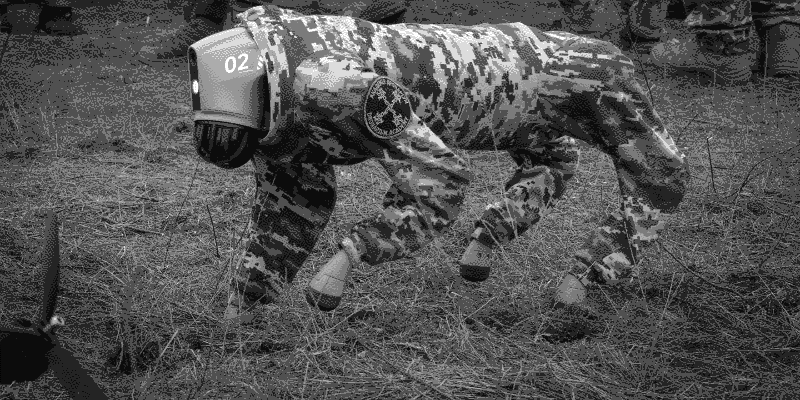At the end of January 2025, while scrolling through my Mastodon timeline, I came across this image of a robot dog soldier used on the Ukrainian front (FIG.01). The image illustrates an article in Le Monde that I've not been able to find since. I download the image immediately and keep it on my computer for several weeks, before reopening it and posting it on the platform to find out its origin. No reply.
This image keeps spinning around in my head, taking me back to my thesis years, during which I spent several weeks studying the notion of “artificial empathy”, as described by Serge Tisseron in his book Le jour où mon robot m'aimera. Beyond the description of the different types of empathy, the links between their layers and, above all, the question of their simulation by robots, I'm reminded of a story he tells in the introduction to chapter 2. In this section, he explains that the American army has been widely confronted with undesirable effects when using robots in the field. The author takes the example of robot spiders which, to clear the ground of mines, place one of their eight legs on the bomb to be defused in order to detonate it, losing a limb in the process. Once completely dismembered, the robot becomes unusable. The resemblance to a spider disturbed the soldiers, who described their treatment as “inhuman”.
In another case, Tisseron describes soldiers being killed trying to retrieve a robot they had been working with for several months or years. According to Tisseron, these actions led the U.S. military to implement rules - rather asimovian:
“Know how robots and AI work.
A mission carried out by a robot must be capable of being carried out by a human.
Its use must always remind the combatant that the machine is a machine.”
(Tisseron, p. 40-41)
To document these facts, I'll quote a passage from my thesis, in which I explain that these recommendations were written by the US Army to help integrate robotics into military operations. Their aim is to ensure that every soldier who comes into contact with this type of machine knows that a machine is still a tool, that it has no emotions and no possibilities other than applying commands, and that it is no more powerful than a human being. This desacralization of the machine modifies the human-machine relationship in a military setting, and attempts to limit the empathic relationship with the tool. This relationship must be limited to the same level of empathy as that which soldiers might have with any object or tool, what with a drastic reduction in the capabilities of these machines.
This type of legislation shows us that it seems difficult to separate human and machine for two major reasons:
- A machine always has a human designer;
- It feeds exclusively on data derived from human experience, which it transforms according to its program. The meaning it produces is coherent only insofar as it is designed to be shared with humans.
Seeing this photograph of a robot dog, I'm surprised to see that thirteen years after writing this book, and after these setbacks for the US army, the choice of a dog-like robot has been maintained. I don't know the ins and outs of this choice or its effects in 2025, but this story of the spider robot is resurfacing.
Here, the robot oscillates between an austere geometric form, with its angles softened in spite of everything, whose face is replaced by these curious indicator lights showing its operation. Even more surprisingly, the robot is dressed in military combat gear to camouflage it. The pattern is classic but pixelated, as if to underline the digital nature of the robot-dog through its uniform. He is, however, part of the team, intrinsically linked to field actions.
His presence reminds us of the intimately digital nature of the conflict and the complex relationship between the real and the virtual - in Pierre Lévy's sense that virtualizing is equivalent to desynchronizing and delocalizing. This point is highly intriguing in the context of war, since this dog, not being a living being, does not function directly in the real world, but acts thanks to a set of pre-recorded possibilities, coming from a location other than the one in which it is. This set of data is updated on demand in the field where it is active. Yet its appearance and uniform give it a special presence, making it part of a battlefield representation, with undoubtedly very concrete effects on the adversary.
It's as if the robot's plasticity has become an artifice to hide its intrinsic virtuality.
Pierre Lévy, Qu'est-ce que le virtuel ?, Paris : La Découverte, 1998, 154 p.
Serge Tisseron, Le jour où mon robot m’aimera. Vers l’empathie artificielle, Paris : Ed. Albin Michel, 2015, 186 p.

FIG 01. Image of the robot-dog posted by Le Monde